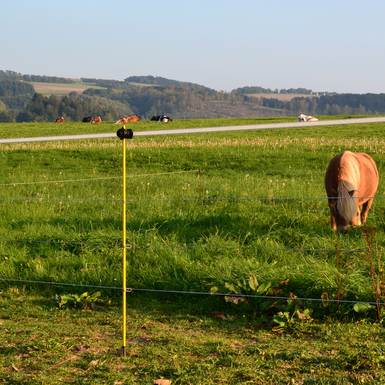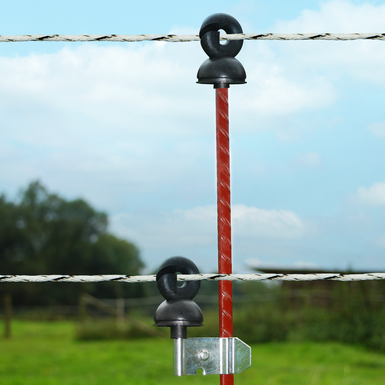Electric fence posts
A pasture fence must be able to withstand high loads and weather conditions. This is guaranteed by sturdy pasture fence posts. Our stakes are characterised by high quality and durability. In our online shop, we offer you a large selection of pasture fence posts in various sizes and designs.
Choose Category
Fibreglass posts Strong Line 120, 120cm high, 5 pieces, with double tip.
- The fibreglass posts are extremely robust and weatherproof thanks to their material
- 5 stakes made of black fibreglass with a height of 120 cm, a diameter of 13 mm and a double tip
- Extremely light and stable - the fence stakes are particularly easy to handle and the practical step makes it easy to erect the stakes
- The insulators are individually adjustable in number and height and meet the requirements of safe fencing
Things to know about pasture fence posts
Topic overview
- Mobile and fixed fence posts
- Purpose of pasture fence stakes
- Choosing the right stakes - materials and properties
- The right post spacing
- How deep do pasture fence posts have to be driven into the ground?
A basic distinction is made between mobile and fixed fencing. Both types of fence have different requirements for fence posts, which form the basic framework of any fencing system.
The posts of a fixed fence must be particularly durable and long-lasting. After a one-time, somewhat time-consuming installation, hardly any work is required afterwards. Mobile fences have the advantage of flexible handling. They can be moved without a great deal of time and thus all kinds of areas can be used as grazing areas at short notice.
The posts used should have the corresponding properties: quick and easy to move and yet robust for a safe and stable fence.
These are available from us in various heights and colours, as well as double and single spikes.
Purpose of the pasture fence stakes: Corner and line stakes
They are differentiated in their application into corner posts and line posts, also called intermediate posts.
- Corner posts/corner posts
Corner posts are used for significant changes of direction, corners, fence starts and ends, and gates. These posts are subject to particularly high requirements because the conductor materials are brought together here and the tensile forces resulting from the tensioned conductor material must be absorbed accordingly. Corner posts are therefore decisive factors for the stability of the entire fence system and must ensure optimal support.
- Line posts/ intermediate posts
Distance posts are positioned between the corner posts and guide the tensioned conductor material along the fence via insulators. Be sure to fit suitable insulators to your pasture fence posts to avoid contact between the post and the conductor material and to counteract resulting voltage drops on the electric fence. Some post variants already have insulators integrated.
Which pasture fence post is the right one?
For a pasture fence, there are posts with different materials and properties:
Wooden fence posts
- are considered the environmentally friendly classics among fence posts
- are extremely break-resistant and particularly weatherproof due to pressure impregnation
- blend in very well with the landscape
This type of post is mainly used for fixed fences, as it is particularly stable. However, many users also use wooden posts as corner posts for mobile fencing systems in order to be able to withstand the high tensile forces of the fencing system.
Recycled posts
Poles for a pasture fence made of recycled plastic are also convincing with their high stability and breaking strength.
The processing (screwing, drilling, sawing or nailing) with common tools is very easy, similar to the wooden post. The post also does not splinter, so there is minimal risk of injury when working on it.
This fence post is made from recycled plastics and can therefore be recycled again. It guarantees unlimited durability and offers individual adjustment of the holes for insulators.
Thanks to the rot-proof material, deep anchoring in the ground poses no problems whatsoever for authoritative fence stability.
Similar to wooden fence posts, recycled posts are mostly used for fixed fencing and/or as corner posts for mobile fencing to provide the required support for the fencing system.
T-post
The 1.5 m high pasture fence posts are made of recycled steel and are characterised by their high stability and durability.
T-posts are all-rounder pasture fence posts. They can be used flexibly as corner, line, gate, start and end posts.
They can be used for fixed fencing systems as well as for mobile fencing, because the properties of these fence posts can be classified between the two extremes, wooden posts and plastic posts.
For construction, there are special rams and pullers that make your work with the T-posts easier.
Steel posts
In our shop assortment you will find steel fence posts in two versions: angle steel posts and spring steel posts.
Both post variants are used for both fixed and mobile fencing systems.
High-quality spring steel, characterised by high stability, prevents deformation of the pasture fence posts and ensures a secure hold.
The use of spring steel posts makes it possible to fence in sheep, cattle and horses all year round. A head insulator is already integrated in this post variant. Further insulators can easily be mounted at any height.
Angle steel posts are extremely stable and durable pasture fence posts. They are easy to anchor in the ground and, thanks to the angle profile, they also have high stability and secure anchoring in the ground, which is why this model of pasture fence post is also excellently suited as a corner post for a mobile pasture fence. Even with fixed fence systems, angle steel posts provide sufficient stability for a secure fence system due to their robust and stable design.
Metal stakes are the ideal solution for those looking for durable and robust fence posts.
Plastic stakes
Plastic posts are very popular for mobile fencing systems in the form of line posts. The horizont plastic fence posts are particularly easy to handle and yet relatively stable and durable. They are made of high-quality plastic, are UV-stabilised, break-resistant and weatherproof.
Another advantage of these grazing stakes is that they are quick and easy to assemble, which makes them ideal for mobile use.
Our range offers a wide selection of stakes for your pastures, differentiated in height, colour and features and, if chosen correctly, will thus find use for animals such as horses, cattle or sheep.
Fibreglass stakes
Fibreglass posts are the professional version of mobile fence posts. As with the plastic post, electric fence posts made of fibreglass also have a metal tip that is driven into the ground, making them quick and easy to erect. Easy and flexible repositioning of the posts is also possible at any time, making them particularly attractive for mobile use.
Compared to conventional plastic posts, fibreglass fence posts are characterised by their remarkably light weight and particular stability and durability. They are particularly handy in the field and easy to transport.
Tip: tipping stakes?
Do your poles tip over frequently? This would pose a high risk for you as an animal owner and for your animals. Roadway stakes only hold in the ground to a limited extent. It is therefore important to use corner posts correctly, as they absorb the tension and hold them securely and stably from corner to corner post. For plastic posts, a long and wide soil nail is suitable for a better hold in the ground.
What heights and spacing should the posts have?
The height of your pasture fence depends on the type of animal you are herding. Above all, the size of your animals and their jumping ability must be taken into account. If you also keep young animals in the pasture, your fence must be extended downwards.
In general, the wider or heavier the ladder material, the closer the posts must be in wind-prone regions. The distances also differ depending on the ladder material used.
- Strand and wire: 6 m to 8 m (depending on own weight)
- Tape: 3 m (with 40 mm wide tape), 5 m (with 20 mm wide tape), 6 m to 8 m (with 10 mm wide tape)
- Electric cable: 4 m (for diameter 6-8 mm), 6 m (for diameter 5-6 mm)
Please take into account your local conditions! If the terrain is very uneven, several pasture fence stakes are required to guide the conductor material parallel to the ground.
When using plastic stakes as line stakes, you can easily transfer the height for the insulators to the corner stakes or stakes for changes of direction by inserting the plastic stake into the ground next to the wooden or recycled stake and transferring the height of the eyelets to it. Our eyelets are suitable for strands, wires, wide bands and ropes in various sizes.
How deep do pasture fence stakes need to be driven into the ground?
The stakes form the basic framework of a stable electric fence. For this reason, it is important to anchor them deep enough into the ground to ensure sufficient stability. It is recommended that the electric fence post be driven in at least up to a quarter of its total length. Since corner posts are under a particularly high load in the fence system, they should be anchored in the ground 1/3 of their total length.
Plastic posts, fibreglass posts or other pasture fence posts that have a ground spike/ground nail are excluded from this recommendation and must be driven/inserted into the ground according to the length of the ground nail.








